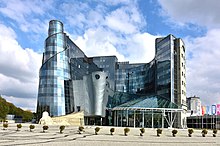Polish postmodernism

| Postmodernism |
|---|
| Preceded by Modernism |
| Postmodernity |
| Fields |
| Reactions |
| Related |
Polish postmodernism refers to the
Background
The discourse on the philosophical concept and literary awareness of

In the Polish context, postmodernism has been categorized by literary critics as the framework of pluralism necessary for the success of European integration as far as post-national diversity and regional differences are concerned.[6]
The official welcome of postmodernism in post-communist Poland was somewhat late; it met with severe impediments not so much from the former communist establishment as from Solidarity itself and the Catholic Church, both of which promoted "collectivist" rather than "liberal" values.[6] However, beginning in the 1990s and throughout the early 21st century, postmodernism began to take a firm hold especially in the realms of poetics and art theory. Polish architects (Czesław Bielecki, TVP; Marek Budzyński) and selected filmmakers (i.e. Kieślowski, Machulski, Agnieszka Holland, Komasa: the Suicide Room) contribute substantially to the Polish postmodernist anti-foundationalism in popular culture.[6][7]
Artistic origins
Although postmodernism was widely promoted in the so-called Drugi obieg (the Second circulation) by
Postmodernism entered Poland in the 1960s at the end of the
See also
- History of Poland (1945–1989)
- History of Poland (1989–present)
- Modernism and Postmodernism
- Polish literature
- Socialist realism
Notes and references
- )
- )
- ^ )
- ^ Instytut Teatralny (2010). "Author: Samuel Beckett". Baza realizacji – rejestr archiwów (Database) (in Polish). Instytut Teatralny im. Zbigniewa Raszewskiego. Retrieved March 22, 2013.
- ^ Prof. dr hab. Miłosława Bulowska Schielman. "Stanisław Ignacy Witkiewicz". Virtual Library of Polish Literature. Retrieved December 13, 2011.
- ^ a b c d e f Eugeniusz Górski (February 13, 2009). "From 'Socialist' to Postmodern Pluralism in Poland". Chapter 7. The Council for Research in Values and Philosophy (RVP). Archived from the original (WebCite query) on April 13, 2011. Retrieved March 18, 2013.
{{cite web}}: External link in|format= - ^ Prof. Justyna Beinek. "Post-Communist Polish Culture (1989-Present)" (PDF file, direct download 66 KB). Topics in Polish Literature and Culture (Slav-P365/565). Indiana University. Retrieved March 23, 2013.
- JSTOR 25778784.
- )
- ^ Małgorzata Kitowska-Łysiak, Institute of the Catholic University of Lublin (December 2001). "Andrzej Wróblewski". Resources: Visual Arts. Adam Mickiewicz Institute Culture.pl. Retrieved March 27, 2013.
- )
